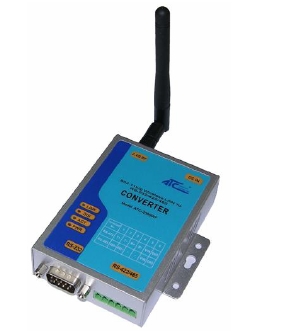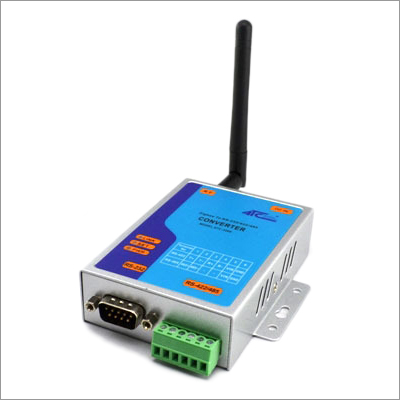
Wireless Communication Converter
Price 7500.00 INR/ Box
Wireless Communication Converter Specification
- Product Type
- Wireless Communication Converter
- Storage Channel
- 16 Channels
- Interface
- RS232/RS485
- Power
- 12V DC
- Current
- 250 mA
- Material
- ABS Plastic
- Dimension (L*W*H)
- 110 x 75 x 22 mm
- Weight
- 350 g
Wireless Communication Converter Trade Information
- Minimum Order Quantity
- 1 , , Box
- Supply Ability
- 100 Boxes Per Month
- Delivery Time
- 7 Days
About Wireless Communication Converter
Wireless Communication Converter is appropriate in wireless check meter, industrial data acquisition, and pan-tilt control for regulating and repeating the data. Obtainable converter is serving its use in numerous meters counting gas, water, electricity, building control and arrival access records.
Other Details:a
- Model No.KH702
- Wireless Communication Converter:
Application:
KH702 wireless communication converter can attain USB port to wireless communication or RS485 port to wireless communication, extensively utilized in wireless examination meter, manufacturing pan-tilt control, data gaining, and etc. area, like for data control and data reproduction in meters of electricity, water, and gas, arrival guard access record, structure control, burglar alarm, goods yard logistics, intelligent instrument and meters, involuntary control, brainy home etc area.
Technical Specification:
- Communication port: USB /RS485 wireless communication
- Communication rate: 9600 default
- Signal channels no: 8(can be expand to 16 if required)
- Transmit &Receive time: 10ms
- Working frequency: 433MHZ, no need to apply for ISM frequency band
- Size: 103.5x96x39mm (LxWxH)
Versatile Communication Solutions
This converter effectively bridges industrial control devices, ensuring seamless wireless connectivity between PLCs, HMIs, and PCs. The detachable antenna enhances signal flexibility, making the unit adaptable for varied installation environments and expanding its communication range.
Reliable and Robust Design
With an ABS plastic enclosure rated IP30, the product is built for durability in demanding industrial settings. The LED indicators provide immediate insight into power and communication status, facilitating real-time monitoring and rapid troubleshooting by personnel.
FAQs of Wireless Communication Converter:
Q: How does the wireless communication converter connect with PLC, HMI, or PC systems?
A: The converter supports RS232 and RS485 interfaces, enabling direct wired connections to PLCs, HMIs, or PCs. It wirelessly transmits data between devices using FSK/GFSK modulation, offering reliable signal quality.Q: What benefits does a detachable antenna provide for this converter?
A: A detachable antenna allows users to easily replace or upgrade the antenna to suit specific installation needs, helping optimize signal strength and coverage in different environments.Q: When should I use DIN Rail versus wall mounting for installation?
A: DIN Rail mounting is preferable in control cabinets or industrial panels for neat, secure placement. Wall mounting works better in rooms with available surface space or when panel integration is not required.Q: Where is the wireless communication converter typically used?
A: This converter is commonly deployed in industrial automation setups, process monitoring stations, and factory floors throughout India, enabling seamless device integration and remote control.Q: What is the process for setting up channels and baud rates on this converter?
A: Users can configure up to 16 storage channels and adjust baud rates from 1200 to 19200 bps through the device interface. Refer to the product manual for step-by-step instructions tailored to your system requirements.Q: How do the LED indicators assist in the converters operation?
A: LED indicators display power and communication status at a glance, helping operators monitor device functionality and detect issues promptly for efficient maintenance.Q: What advantages does the ABS plastic and IP30 enclosure offer?
A: The ABS plastic build ensures the converter is lightweight yet durable, while the IP30 rating protects internal components from dust and accidental contact, ideal for indoor use in industrial environments.

Price:
- 50
- 100
- 200
- 250
- 500
- 1000+
More Products in Wireless Communication Converter Category
Wireless Converter
Price 7500 INR / Box
Minimum Order Quantity : 1 Box
Frequency Range (Hz) : 500 mtr Hertz (HZ)
Talk Range : 500 Meter
Power : <100 Mw (ATC863 & ATC871) Watt (w)
Weight : 0.6 Kilograms (kg)
Mini Wireless Converter
Price 14000 INR / Piece
Minimum Order Quantity : 1 Piece
Frequency Range (Hz) : 2000 mtr Milihertz
Talk Range : Up to 2000 meters (line of sight)
Power : <800 Mw Watt (w)
Weight : 0.6 Kilograms (kg)
 |
MICON AUTOMATION SYSTEMS PVT. LTD.
All Rights Reserved.(Terms of Use) Developed and Managed by Infocom Network Private Limited. |

 English
English Spanish
Spanish French
French German
German Italian
Italian Chinese (Simplified)
Chinese (Simplified) Japanese
Japanese Korean
Korean Arabic
Arabic Portuguese
Portuguese Send Inquiry
Send Inquiry


